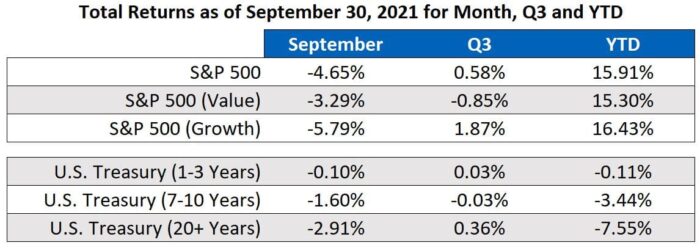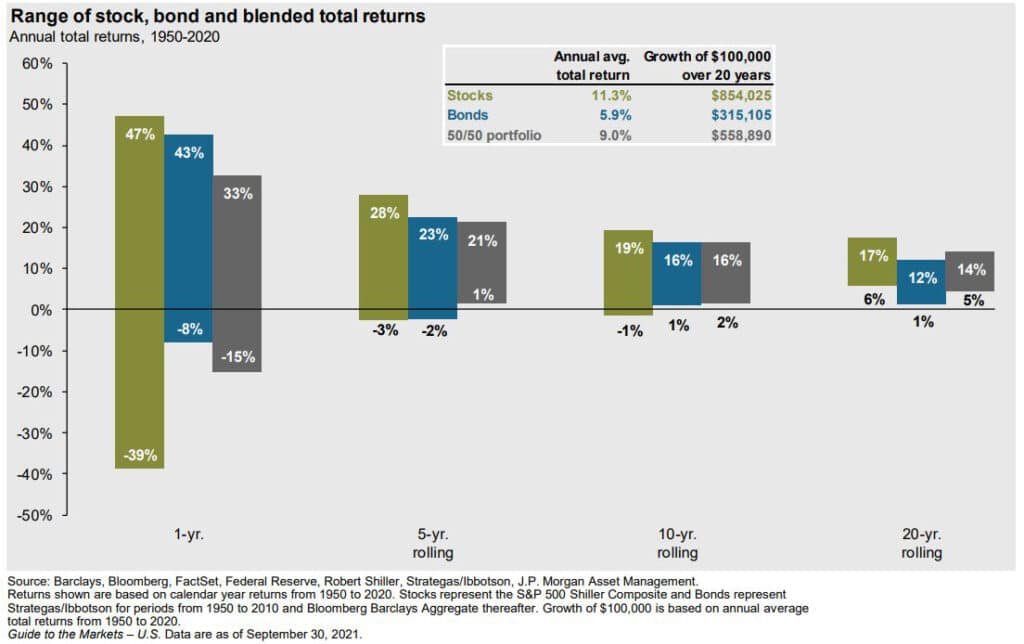
Dear Clients:
U.S. stocks marched steadily higher through the summer, with the S&P 500 reaching a record high on September 2 (the NASDAQ Composite peaked five days later). Unfortunately, September has been the weakest month for U.S. stocks going back to 1950 and 2021 was no exception, with the S&P 500 suffering its worst monthly loss since the start of the pandemic. Indeed, the headline on the front-page of the October 1 issue of The Wall Street Journal proclaimed “Stocks End Quarter in Turmoil, Worst Month Since March ’20.”
In spite of this fearsome headline, our equity portfolio still eked-out a small gain for the third quarter of 2021 and remained up mid-teens for the year-to-date. We’re invested alongside you and satisfied where we stand at this point in 2021, but will not be surprised to see continued heightened volatility as we head into year-end.
As you’re well aware, the past five years in particular have been extraordinarily difficult for active, “value” investors like us. We believe to produce better-than-average long-term results, you need to own a portfolio that’s different than the average. We evaluate companies as if we’re buying the entire business. We look for stocks our analysis says trade at a reasonable discount to what that business is worth and have a future catalyst in sight to narrow that gap.
While we firmly believe that strategy is sound, it has certainly not been rewarding recently. We’ve been frustrated stocks we buy at cheap valuations (i.e. could double in price and still be attractive) have struggled while stocks with absurdly high valuations (i.e. not profitable anytime soon and could be cut in half and still be overpriced) have soared. However, as shown in the table below, a shift in fortunes may have begun in September, as the S&P 500 Value index dominated the S&P 500 Growth index in September, leading to a solid outperformance by “value” in the third quarter.

As the calendar flips to October, investors face various “ghosts and goblins,” including the COVID-19 Delta variant (which is hopefully declining), an uptick in interest rates, stubbornly high inflation, the impending collapse of one of China’s largest real estate developers (China Evergrande Group), the recurring brinksmanship over raising the federal debt ceiling to forestall the government from defaulting on its debt and the Federal Reserve’s removal of pandemic-related emergency measures (see our Indianapolis Business Journal column, “Don’t Be Spooked By Fears of Another ‘Taper Tantrum’ here).
After stocks encounter turbulence, it’s natural to wonder if it was just a “normal” short-term blip or the start of something more ominous. There is no shortage of opinions from the various market mavens and soothsayers, but the answer will only be apparent in hindsight. No matter what they say and how loudly they say it, nobody can predict the outcome of the numerous risks and challenges facing investors.
In tumultuous times, we think it’s beneficial to take a step back and try to shed some light instead of creating heat. There is too little of the former and way too much of the latter.
Stocks are inherently volatile and long periods of calm are the exception, not the rule. According to Crandall, Pierce, as of the close of trading on September 30, 2021, the S&P 500 had recorded its 192nd decline of 5% or more since 1945. Further, this decline was long overdue, given the S&P 500 had not dropped 5% in the 293 calendar days since recovering from the near-10% sell-off prior to the November 2020 election. Stated differently, until the end of September 2021 it had been almost a year since the last 5% drop, whereas since 1945 the S&P 500 has experienced 5%+ drops about 2.5 times per year. Nobody can say if this 5% drop will lead to a “correction” (10-20% drop) or even a “bear market” (20%+ drop), but extreme volatility is a normal part of investing in stocks and no reason to deviate from your plan.

Related to the above, the shorter the time frame you choose to focus on and the more you worry about stuff you can’t control, the more volatility and stress you will experience. It is often said stocks “climb a wall of worry.” There is literally always something to worry about. Kirr, Marbach opened its doors on May 1, 1975, what must have seemed like a terrible day to start a business. The prior day, Saigon fell and the U.S. lost the Vietnam War, with the Dow Jones Industrial Average (DJIA) closing at 826.34. Fast forward to the Global Financial Crisis when the DJIA bottomed at 6547.05 on March 9, 2009. More recently, the DJIA plunged to 18,591.93 at the peak of pandemic fear on March 23, 2020. It closed at 33,849.92 on September 30, 2021. Long-term success depends on discipline and a strong stomach!
The illustration below from J.P. Morgan Asset Management displays returns over the seventy-year period from 1950-2020 for portfolios with asset allocations of 100% stocks, 100% bonds and 50% stocks/50% bonds. If you had invested $100,000 at the start of rolling 20-year periods, on average you would have ended up with almost three times as much money at the end with 100% stocks ($854,025) vs. 100% bonds ($315,105). Additionally, while the average annual return for stocks was 11.3%, returns ranged from 47% to minus 39%, which is a much wider range than most people would think. Looking out to 20-year rolling periods, returns tightened significantly to a range of 17% to 6%.
In other words, while stocks have historically returned materially more than bonds, stock returns are tremendously volatile over short-periods of time (like one-year), but much less volatile as your investment horizon expands towards 20-years.

Carl Richards of Behavior Gap has an uncanny ability to make complex financial concepts easy to understand, using only a Sharpie and a cocktail napkin. According to Richards, when it comes to investing, we have a choice on what we focus on. He said, “you can tune in to the financial pornography network, go through endless cycles of ‘buy sell, buy sell,’ obsess over the latest IPO and deal with the apocalypse du jour while cycling through all the emotions that come with it, OR you can focus on what actually matters when it comes to investing. And that’s time. A very long time: decades.”
Richards continued, “if you choose to focus on days, you are signing up to make yourself miserable. And for no good reason. There’s actually no benefit to that. I can handle the pain that leads to gain, but this is just pain that leads to more pain.” “On the other hand,” he said, “when it comes to investing, we actually get rewarded for ignoring the daily noise.” In conclusion, “remember, you have a choice. Days or decades. What’s it going to be?”

As noted, September has historically been the worst month of the year for stocks. However, October begins what has been the best quarter of the calendar (Q4). According to Sam Stovall, Chief Investment Strategist of CFRA, “the S&P 500 typically saves the best for last.” Stovall noted, “whether looking at all years since 1945, or just the first year of the 16-quarter presidential cycle, the S&P 500 recorded its highest average price change in Q4, as well as its highest frequency or price gains.” There are no guarantees, but he expects a “favorable finish” in 2021.

Summary
We’re pleased we’ve been able to make up significant ground since the March 2020 low. We are confident our strategy to increase the size and quality of the companies in the portfolio, while still maintaining our “Value” discipline, will prove to be correct. We think it’s interesting to note the relative performance pendulum started swinging in favor of “Value” in September of 2020 and “Value” had similar relative strength in September of 2021, as most of the mega-capitalization technology stocks that have dominated performance for the past several years stumbled more than the overall market (Facebook -10.5%, Apple -6.8%, Amazon -5.4%, Microsoft -6.6% and Alphabet (Google) -7.6%).
As always, we’re big believers in “eating our own cooking” and have significant personal investments alongside you. We’re investing your precious assets the same way we’re investing our own. In other words, we’re putting our money where our mouths are.
We thank you for the trust and confidence you’ve placed in us and pledge to work our hardest every day to earn it.
KM Privacy Policy Notice
Under Securities and Exchange Commission Regulation S-P, KM is required to deliver its Privacy Policy Notice to each client prior to the establishment of an account and updates annually. We are delivering our 2021 annual update to each client account with this letter. In addition, given the increasing importance of protecting clients’ personal information, we have implemented a policy whereby KM personnel will not release any information about a client’s account without specific authorization from the client. If you would like KM to release information about your account to your CPA or other service provider, please contact Director of Client Service Matt Kirr ([email protected]), Associate Director of Client Service Zach Greiner ([email protected]) or Associate Director of Client Service Maggie Kamman ([email protected]) by e-mail or at 812-376-9444 or 800-808-9444.
Regards,
Kirr, Marbach & Company, LLC
Past performance is not a guarantee of future results.
The S&P 500 Index is an unmanaged, capitalization-weighted index generally representative of the U.S. market for large capitalization stocks. This index cannot be invested in directly.
The S&P 500 Value Index is an unmanaged, capitalization-weighted index that measures the performance of the value segment of the U.S. market for large-capitalization stocks. This index is a subset of the S&P 500 Index and cannot be invested in directly.
The S&P 500 Growth Index is an unmanaged, capitalization-weighted index that measures the performance of the growth segment of the U.S. market for large-capitalization stocks. This index is a subset of the S&P 500 Index and cannot be invested in directly.
The Dow Jones Industrial Average (“DJIA”) is an unmanaged index comprised of common stocks of thirty major industrial companies. This Index cannot be invested in directly.
Subscribe
Subscribe to stay up to date with the latest news, articles and newsletters from Kirr Marbach.












